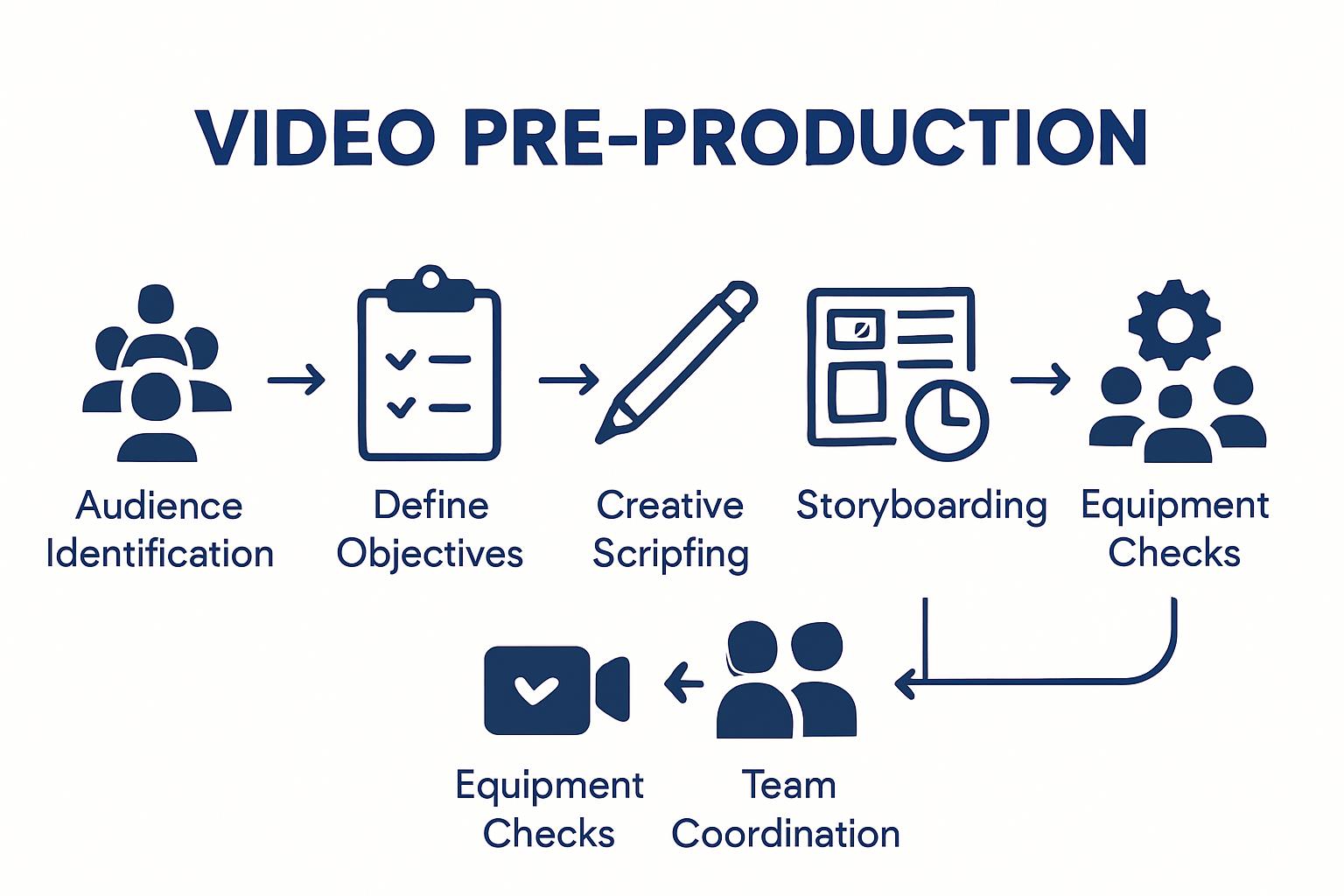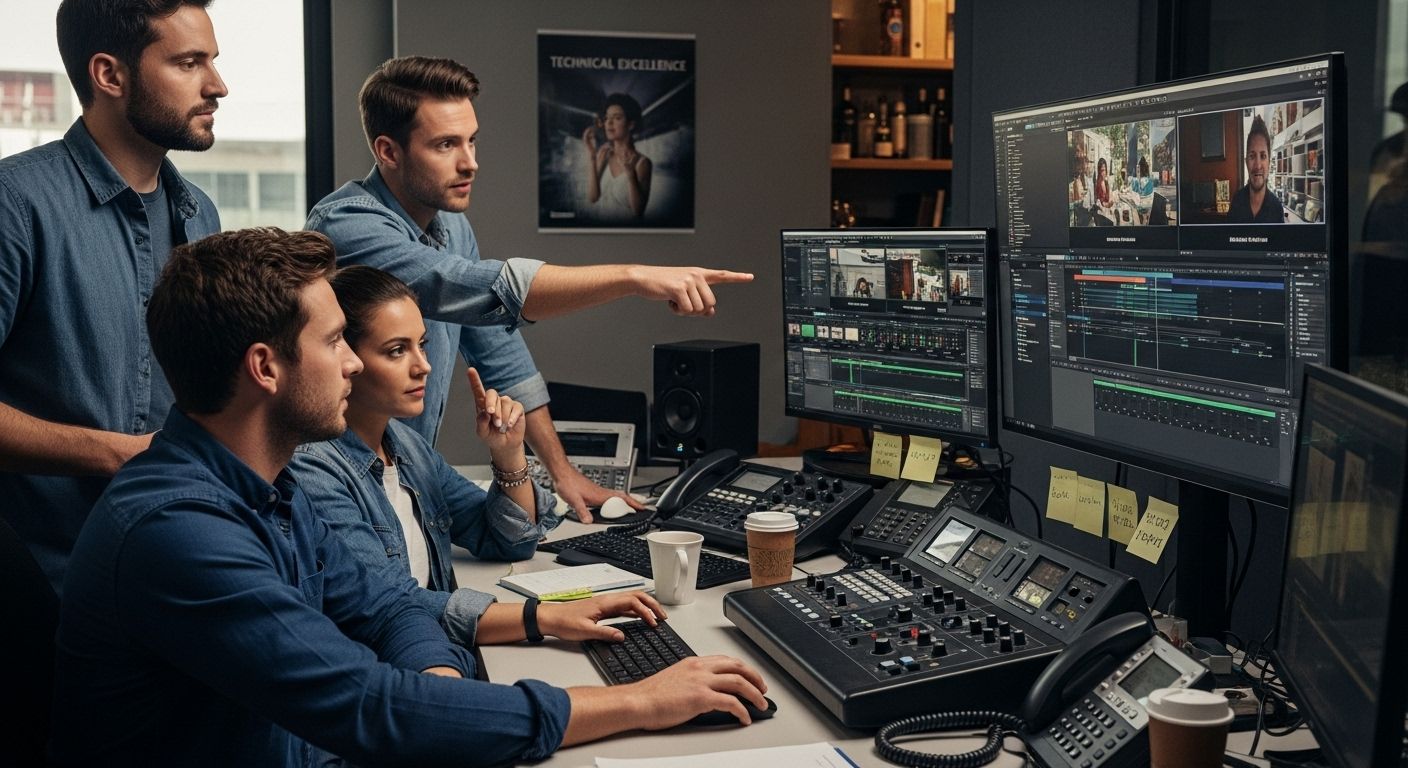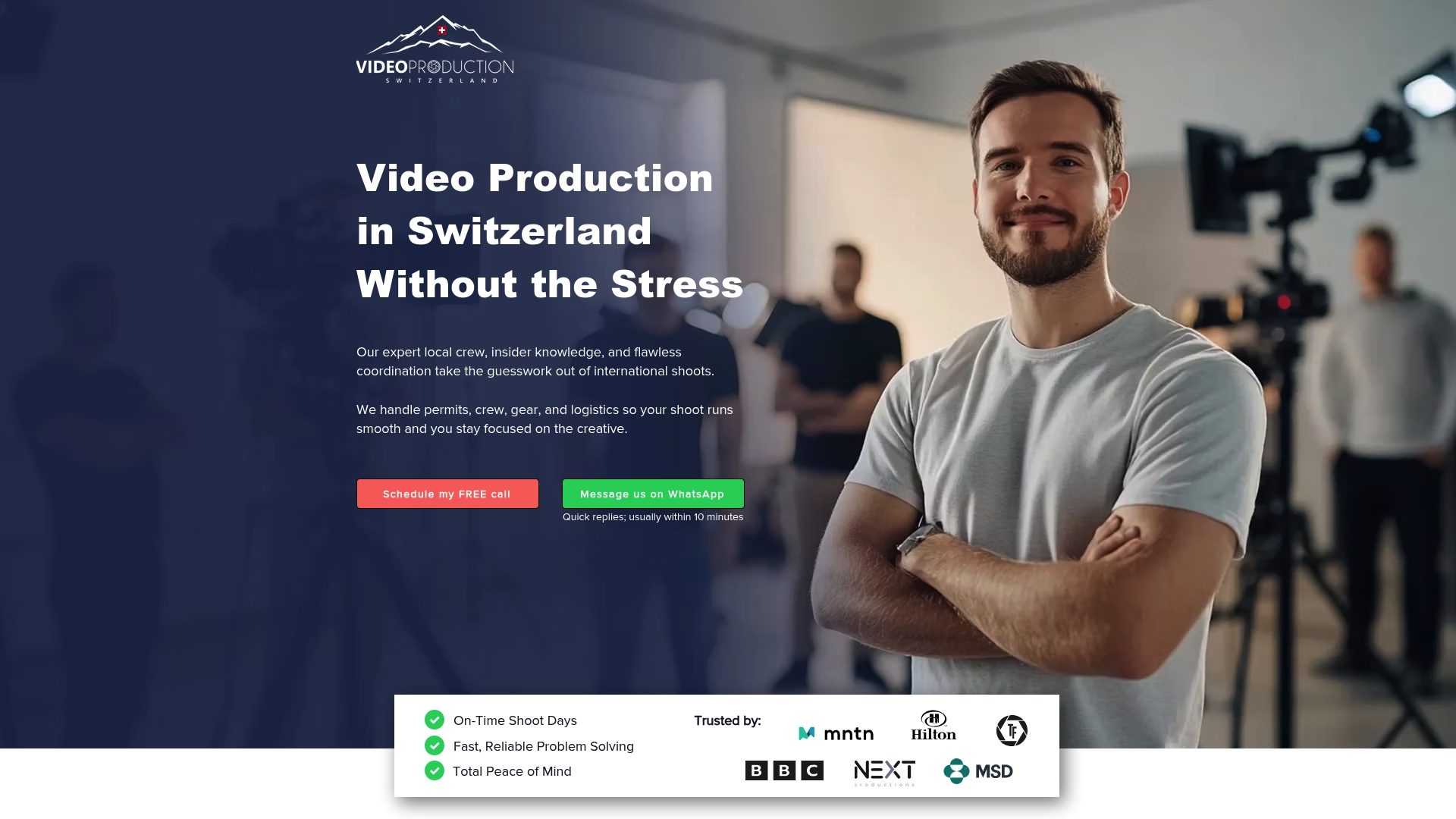Video Production Best Practices for Creative Success
- info1419758
- Aug 10
- 9 min read

Video production can seem like endlessly juggling cameras, scripts, and deadlines, all while hoping your story actually lands with your audience. Yet, despite all the gear and creative ambition, studies show that poor audio alone can stop viewers from finishing even the most visually stunning videos. Most surprising of all, the secret to truly memorable content is not just top-notch equipment or perfect lighting. It all comes down to meticulous planning, emotional storytelling, and thinking globally, right from the very first brainstorm.
Table of Contents
Quick Summary
Takeaway | Explanation |
Establish clear project objectives | Define your audience, desired outcomes, and unique value. This foundational step guides all creative and technical decisions in your project. |
Prioritize comprehensive pre-production planning | Thoroughly plan scripts, storyboards, and logistics to avoid complications and enhance video quality throughout production. |
Maintain technical excellence across all aspects | Invest time in high-quality equipment, audio setups, and post-production techniques to elevate the storytelling and viewer experience. |
Master creative storytelling for emotional impact | Craft narratives that resonate with audiences by focusing on authentic emotional engagement and structured content architecture. |
Ensure global reach through cultural sensitivity | Design content with universal appeal and awareness of cultural nuances to effectively connect with diverse audiences worldwide. |
Planning Your Video Project Efficiently
Successful video production starts with meticulous planning. Without a strategic approach, even the most creative projects can quickly spiral into costly, inefficient endeavors. Video production best practices demand comprehensive preparation that addresses every critical aspect of your project before cameras start rolling.
Establishing Clear Project Objectives
Before diving into technical details, filmmakers must answer one fundamental question: Why would someone want to watch this video? This critical inquiry helps define the core purpose and potential impact of your production. According to research from Georgia Tech’s communication resources, every video should meet specific standards that justify its creation.
Defining clear objectives involves more than just a broad concept. You need to articulate:
Specific audience targeting: Who exactly will watch your video?
Desired outcome: What action or emotion do you want to provoke?
Unique value proposition: What makes your video different from similar content?
Comprehensive Pre-Production Planning
Pre-production is the foundation of efficient video creation. As detailed by the Office for Victims of Crime, a detailed preproduction plan can significantly enhance video quality while preventing unnecessary expenses. This phase encompasses several critical steps:
Brainstorming and conceptualization require collaborative thinking. Gather your creative team and systematically explore potential narrative approaches, visual styles, and technical requirements. Create a robust storyboard that visualizes each scene, helping everyone understand the project’s creative vision.
Script development is another crucial element. A well-crafted script provides a roadmap for your entire production, outlining dialogue, scene transitions, and key narrative beats. It serves as a blueprint that keeps all team members aligned and focused.
Resource Management and Logistics
Effective resource allocation separates professional productions from amateur efforts. This means carefully inventorying and scheduling:
Equipment needs
Personnel requirements
Location logistics
Budget constraints
Professional video producers understand that every detail matters. From lighting and sound equipment to crew scheduling and location permits, meticulous planning prevents last-minute complications. Consider creating a comprehensive checklist that covers every production aspect, ensuring no critical element is overlooked.
To help you efficiently plan your video project, here’s a summary checklist of the key resource and logistics considerations discussed above.
Resource/Logistics Area | Key Considerations |
Equipment Needs | Inventory cameras, lighting, sound, and backup gear |
Personnel Requirements | Schedule crew, assign roles, ensure skill alignment |
Location Logistics | Secure permits, check accessibility, plan for weather and contingencies |
Budget Constraints | Allocate funds for all phases, anticipate unexpected costs |
Scheduling | Coordinate shoot dates, plan for setup/teardown time |
Documentation & Checklists | Prepare comprehensive checklists for pre-production and shoot days |

Technology and human expertise must work in harmony. While advanced equipment can elevate production quality, skilled professionals who understand how to leverage those tools are equally important. Invest time in selecting the right team members who not only possess technical skills but also align with your creative vision.
Remember, planning is not about restricting creativity but providing a structured framework that allows creative expression to flourish. By dedicating significant effort to pre-production planning, you transform potential chaos into a streamlined, efficient video production process.
Technical Excellence in Video Production
Technical excellence transforms good video production into extraordinary visual storytelling. Video production best practices demand a sophisticated understanding of equipment, techniques, and technological integration that goes far beyond basic point-and-shoot approaches.
Advanced Equipment and Technical Setup
According to Columbia University’s Center for Teaching and Learning, professional video production requires strategic equipment selection and precise setup. The foundation of technical excellence starts with understanding how each piece of equipment contributes to overall video quality.
Camera selection involves more than megapixel counts. Professionals consider:
Sensor size: Determines light sensitivity and depth of field
Frame rate capabilities: Impacts smooth motion and slow-motion potential
Dynamic range: Affects detail preservation in challenging lighting conditions
Lighting represents another critical technical element. Professional setups typically utilize three-point lighting techniques: key light, fill light, and backlight. This approach ensures balanced illumination, reduces harsh shadows, and creates dimensionality in your visual composition.
Audio and Post-Production Considerations
Research published in the National Center for Biotechnology Information highlights that audio quality can make or break a video production. Poor sound recording can render even the most visually stunning footage unwatchable.
Professional audio requires:
High-quality microphones matched to specific recording environments
Careful placement to minimize ambient noise
Proper gain staging to prevent distortion
Post-production audio enhancement techniques
Post-production technical excellence involves sophisticated editing software and color grading techniques. Modern video editors use advanced tools that allow precise color manipulation, seamless transitions, and complex visual effects that elevate the storytelling experience.
Technical Workflow and Optimization
The International Journal of STEM Education emphasizes the importance of establishing a systematic technical workflow. This means creating repeatable processes that maintain consistent quality across different production scenarios.
Optimization strategies include:
Standardized equipment calibration protocols
Comprehensive digital asset management systems
Efficient data backup and archival processes
Continuous technical skill development for production team
Technical excellence is not about having the most expensive equipment but understanding how to maximize the potential of available tools. It requires a combination of technical knowledge, creative vision, and meticulous attention to detail.
Below is a comparison table outlining the main elements for achieving technical excellence in video production, summarizing equipment, lighting, audio, and workflow strategies from this section.
Aspect | Key Focus | Best Practices/Features |
Camera Selection | Image quality, depth of field | Consider sensor size, frame rate capabilities, dynamic range |
Lighting | Balanced visual composition | Use three-point lighting: key, fill, backlight |
Audio Recording | Clear, professional sound | High-quality microphones, correct placement, minimize ambient noise |
Post-Production | Storytelling enhancement | Advanced editing, color grading, seamless transitions |
Technical Workflow | Consistency, efficiency | Standardized calibration, asset management, data backup |

Successful video producers treat technology as a collaborative partner, not just a set of tools. They continuously learn, adapt to emerging technologies, and understand that technical mastery is an ongoing journey of skill refinement and creative exploration.
Creative Storytelling and Brand Messaging
Creative storytelling transcends mere visual communication it represents the strategic art of transforming brand messages into compelling narratives that resonate deeply with audiences. Video production best practices demand a nuanced approach that blends emotional intelligence with strategic communication.
Emotional Engagement and Narrative Design
Research analyzing viral advertising reveals that emotional resonance drives video content success. The study examining 25 most shared viral video advertisements discovered that surprise and joy emerged as dominant emotional triggers. This underscores the critical importance of crafting narratives that do more than inform they must emotionally connect.
Successful brand storytelling requires understanding audience psychology. This means:
Identifying core audience emotions: What feelings drive your target demographic?
Creating authentic narrative arcs: How can your brand story feel genuine?
Developing unexpected narrative turns: Where can you introduce meaningful surprise?
Strategic Content Architecture
According to Columbia University’s Center for Teaching and Learning, intentional video design is paramount. Their research emphasizes working from a comprehensive storyboard and applying principles that reduce cognitive load while maintaining viewer engagement.
Effective brand messaging follows specific structural principles:
Front-load compelling content
Address audience challenges immediately
Create clear narrative progression
Maintain concise, focused storytelling
The first five seconds are critical. Google’s marketing insights recommend capturing audience attention rapidly by directly addressing their core problem or desire.
Authentic Brand Voice and Visual Storytelling
Authenticity separates memorable brand stories from forgettable advertisements. Your visual narrative must communicate not just what your brand does, but why it matters. This requires moving beyond surface-level messaging to reveal deeper organizational values and genuine human connections.
Consider your brand’s unique narrative ecosystem:
What fundamental story are you telling?
How do your visuals reflect your core mission?
Can viewers see themselves within your narrative?
Professional video producers understand that storytelling is a delicate balance between strategic communication and creative expression. Every frame should serve the broader narrative purpose, transforming marketing content into meaningful audience experiences.
Technical precision meets creative vision when brands realize that storytelling is not about talking at audiences but creating immersive experiences that invite emotional participation. The most powerful brand messages do not simply describe they transform viewers’ perspectives, creating lasting connections that extend far beyond traditional marketing approaches.
Ensuring Global Reach and Audience Impact
Video production best practices demand a sophisticated approach to creating content that transcends cultural boundaries and resonates with diverse global audiences. Successful international video production requires more than technical excellence it demands nuanced understanding of cultural communication and audience engagement strategies.
Cultural Sensitivity and Universal Storytelling
According to the Teachers Institute, incorporating viewer feedback and peer reviews is crucial for ensuring content maintains cultural sensitivity. This approach helps creators understand how their message might be perceived across different cultural contexts.
Universal storytelling involves:
Avoiding culture-specific references: Use narrative techniques that translate across borders
Focusing on shared human experiences: Emotions and fundamental human stories connect universally
Creating visually driven narratives: Minimize text-heavy content that requires extensive translation
Language considerations extend beyond simple translation. Professional video producers understand that effective global communication requires adapting not just words but entire narrative structures to resonate with diverse audiences.
Engagement and Visual Dynamics
Harvard Graduate School of Education recommends incorporating motion and action to enhance viewer engagement. Dynamic visual elements create universal appeal that transcends linguistic barriers.
Key strategies for maintaining global audience attention include:
Using dynamic motion graphics
Incorporating universal visual metaphors
Creating sequences that tell stories visually
Designing content with international viewers in mind
Technical Considerations for Global Distribution
Columbia University’s Center for Teaching and Learning emphasizes the importance of concise, engaging content. For global audiences, this means creating videos that are:
Ideally under 6 minutes in length
Using a conversational, accessible tone
Incorporating clear visual explanations
Designed with subtitling and translation in mind
Technical considerations for global distribution go beyond content creation. Creators must consider:
Compression formats compatible with global internet speeds
Platform accessibility across different regions
Compliance with international digital distribution standards
Adaptive streaming capabilities
Successful global video production is an intricate dance between technical precision, cultural intelligence, and creative storytelling. It requires creators to think beyond their immediate cultural context, designing content that speaks a universal visual language.
The most impactful videos do not merely communicate information they create shared experiences that bridge cultural divides. By prioritizing universal emotional resonance, technical adaptability, and nuanced cultural understanding, video producers can create content that truly connects with audiences around the world.
Frequently Asked Questions
What are the key steps in planning a video production project?
Successful video production begins with establishing clear project objectives, including defining your target audience, desired outcomes, and unique value propositions. This is followed by comprehensive pre-production planning, resource management, and logistics.
How important is audio quality in video production?
Audio quality is crucial in video production, as poor audio can detract from even the most visually stunning footage. Investing in high-quality microphones and proper sound recording techniques is essential for maintaining viewer engagement.
What techniques can enhance emotional storytelling in video?
Emotional storytelling can be enhanced by understanding your audience’s core emotions, creating authentic narrative arcs, and incorporating unexpected turns in the narrative. This engages viewers and fosters a deeper connection with the content.
How can videos be tailored for a global audience?
To tailor videos for a global audience, focus on cultural sensitivity by avoiding culture-specific references and emphasizing universal human experiences. Additionally, consider language adaptations, visual storytelling techniques, and ensuring that content is visually dynamic to engage diverse viewers.
Turn Best Practices into Flawless Swiss Video Productions
Stressed about aligning creative vision with perfect execution? This article highlights how resource management, crew coordination, and permits can make or break your shoot. Bringing your video project to Switzerland means more moving parts, and even the best creative plans can be derailed by local red tape or unreliable logistics. So why let audio mishaps, permit delays, or equipment challenges interfere with your storytelling?

Experience what seamless production really feels like. Video Production Switzerland transforms your preparation into measurable success. Enjoy fast permits, trusted local crew, the exact equipment you need, and all the logistics handled before you ever land. Ready to bring your global video project to life—on time and without the usual headaches? Visit our landing page now and claim your free consultation. Your next world-class production starts with a single click.
Recommended

Comments